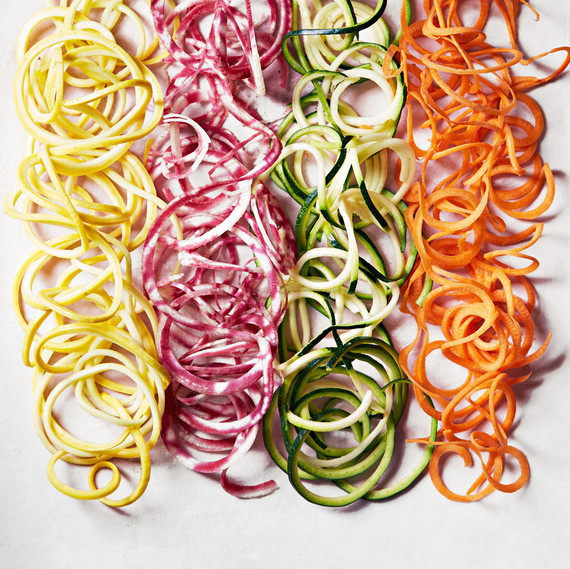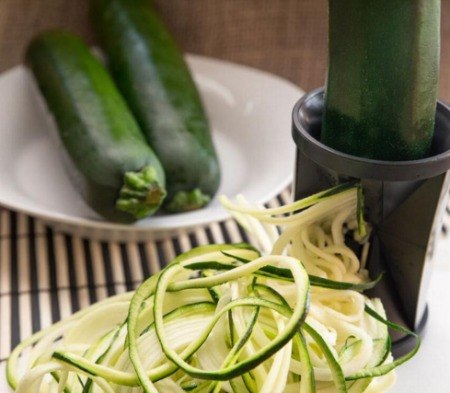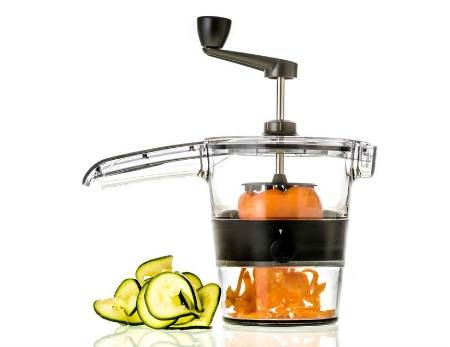Spiralizing vegetables has become extremely popular in the past year due new diets like Paleo, Keto and anything low carb. This is because spiralized vegetables can mimic noodles (which you can’t eat on any low or no carb diet). If you’re unsure about what spiralizer is, take a look at https://spiralizershq.com/, they list all types of spiralizers and how to choose the right one for you. You can also take a look at the images in this article to get an idea of what you can create with a spiralizer. Below is an entire, itemized list of the best vegetables and fruit to spiralize, plus the best practices for cooking your spiralized foods and storing them.

Foods You Can Spiralize
PARSNIP
PEAR
PLANTAIN
RADISH
RUTABAGA
SWEET POTATO
TARO ROOT
TURNIP
WHITE POTATO
ZUCCHINI + SUMMER SQUASH
APPLE
BEET
BELL PEPPER
BROCCOLI
BUTTERNUT SQUASH
CABBAGE
CARROT
CELERIAC
CHAYOTE
CUCUMBER
DAIKON RADISH
JICAMA
KOHLRABI
ONION

How to Cook Spiralized Vegetables and Fruit
Parsnip
Readiness: peel and cut off finishes straight and uniformly.
Cook technique:
Saute, 5-7 minutes
Cook at 425 degrees, 10-15 minutes
Capacity: seal in a water/air proof holder, keeps going up to 10 days in the icebox, can be solidified.
Pear
Planning: remove the stem.
Cook technique:
Serve crude or
Cook at 400, 10-15 minutes
Capacity: seal firmly in a ziploc or impenetrable compartment (to abstain from giving much air access). pears can become dark-colored quite quickly, but they can last up to 5 days in the icebox.
Plantain
Arrangement: peel and cut the closures off equitably and straight.
Cook strategy:
Saute, 5-7 minutes
Broil at 450 degrees, 7-10 minutes
Capacity: seal in an impenetrable holder, endures up to 4 days in the fridge, can be solidified.
Rutabaga
Arrangement: peel and cut closures off straight and equitably.
Cook strategy:
Broil at 425, 15-20 minutes
Saute, 10-15 minutes
Bubble, 5-10 minutes
Capacity: seal in an impenetrable holder, endures up to 7 days in the fridge, can be solidified.
Sweet Potato
Arrangement: peeling is discretionary.
Cook strategy:
Prepare at 425, 10-12 minutes
Saute, 5-7 minutes
Capacity: seal in a bowl secured with ice water, up to 2 days, can be solidified.
Taro Root
Arrangement: peel totally and cut closures off uniformly and straight.
Cook strategy:
Bubble, 2-3 minutes
Saute, 5-7 minutes
Broil at 425 degrees, 15-20 minutes
Capacity: seal tarot root in an impenetrable holder, keeps going up to 3 days in the fridge, shouldn’t be solidified.
Turnip
Readiness: peel totally and cut closures off straight and uniformly.
Cook strategy:
Broil at 425 degrees, 10-12 minutes
Saute, 5-7 minutes
Bubble, 2-3 minutes
Capacity: seal in an impermeable holder, keeps going up to 7 days in the icebox, can be solidified.
White Potato
Readiness: peeling is discretionary.
Cook strategy:
Broil at 425 degrees, 10-15 minutes
Bubble, 3-5 minutes
Saute, 5-7 minutes
Capacity: seal in a bowl secured with ice water, up to 2 days, can be solidified.

Benefits of Owning a Vegetable Spiralizer
1. Efficient
No more spending hours in the kitchen perpetually slashing vegetables with a knife. There are so many different vegetable spiralizers to use for quick and easy sides – it will be the answer to all your kitchen issues. At the point when homemakers gripe about taking hours in the kitchen to set up a better than average supper, it all honestly boils down to how much time it takes to cut the vegetables in the first place. Once your food is prepared, the cooking part is easy. To find out the best vegetable spiralizer for you, it will all depend on your personal needs.
2. Consistency
Vegetable spiralizers can uniform your vegetable cuts or pieces. This not only looks nice, but it makes for easier cooking – everything will be cooked evenly. You will no longer have issues with some of your sweet potato pieces being mushy and some being undercooked. Lastly, even if you aren’t making these vegetables as a meal or side dish, they can make a beautiful garnish at your dinner party. And they are easy to spiralize for small uses like this was a hand held spiralizer that you would just have to rinse after use. (But, if you’re making meals often, I would suggest one of the larger spiralizers).
3. Diverse sharp edges
Although spiralized vegetables sounds like they will be all the same size and width, you actually have options of how you want your spirals to look. It will also depend on what you’re spiralizing and the shape of the fruit or vegetable, whatever food makes you happy. But you can make large, long spirals of foods like pears or apples…. or shorter ones from carrots. You can also choose the thickness/width of your spirals – if desired, they can be more like ribbons (fettuccini sized spirals vs. spaghetti sized ones).
Leave a Reply